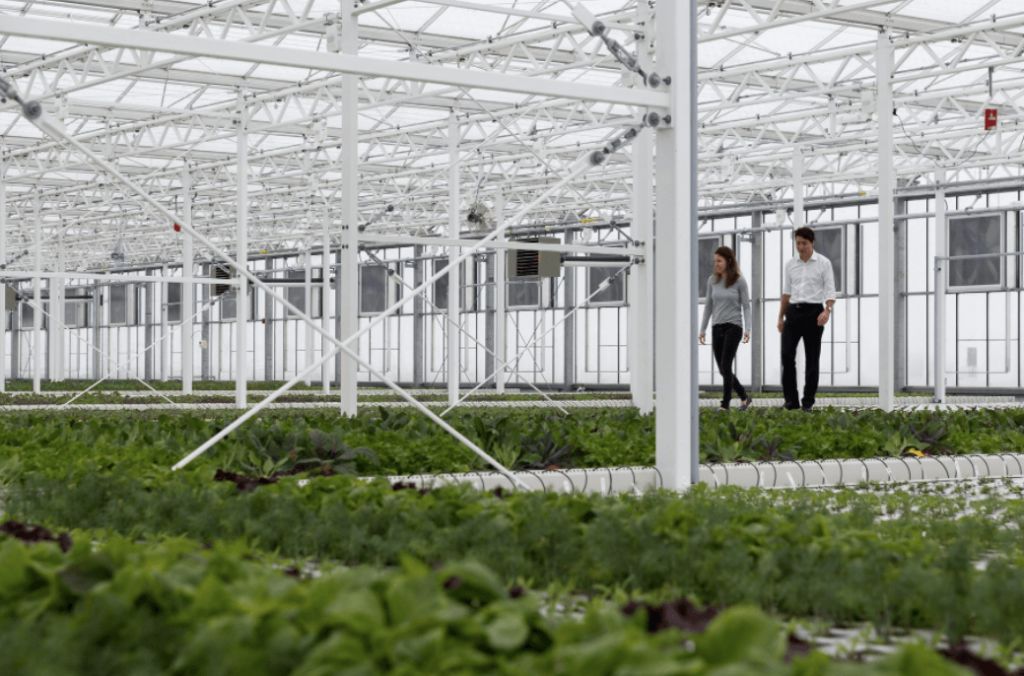Lufa Farms began with a radical concept: to grow food sustainably and closer to the places people reside. The founder and chief executive Mohamed Hage knew this concept is not new. It’s since the centre of traditional agriculture and remains the norm in the region where Hage was raised in Lebanon. Bringing this same philosophy to urban Montreal was an ambitious idea, however, it was partly due to the long winters in Canada significantly limiting the growing season.
Hage along with the co-founder Lauren Rathmell created a business model that adheres to the traditions of local agriculture, but with a modern approach. In the hydroponic rooftop greenhouses, Lufa Farms grows more than 75 varieties of vegetables throughout the year that they offer directly to customers through a subscription-based service.
If the farm’s more than 10,000 members need to purchase fresh produce, they visit Lufa Farm’s site and fill the cart online with selections similar to what they would do at the grocery store. Each week, Lufa Farms delivers deliveries of the chosen products to pick-up locations within two hours of their farm. In order to expand their greenhouses to accommodate the growing demand for all-year-round local fresh produce, Lufa Farms needed to establish a new growth system to improve its efficiency.
The Challenge
In any urban farming operation, space is restricted. With its most recent and biggest greenhouse, Lufa Farms needed to increase the size of operations without compromising its quality products. The most difficult part was the seeds. In the absence of sufficient light and space, it required the team to come up with a different method to the traditional greenhouse setup used for propagating seedlings. Because plants are extremely vulnerable at the beginning of their life cycle, establishing the right conditions for seedlings is the mainstay of the product and the ability of the company to offer top quality products to its customers.
The Solution
Lufa Farms was sceptical about the use of LED lights for growing fruits and vegetables due to the initial expense and risk of the result. By themselves, the team was not equipped with the technological knowledge to evaluate the right lighting technology that would allow their business to grow while reducing risk. Collaboration in partnership with Hort Americas and Current has erased their doubts and set them on a different path.

“Our knowledge of LEDs was abysmal. We rely on their knowledge as well as their advice and it’s been demonstrated to be effective. I would highly recommend it. Most growers don’t have the necessary expertise to make these decisions for themselves. The likes of Chris Higgins at Hort Americas in conjunction with Engineers at Current and Current, are able to combine the knowledge of growers and bring this information together to come up with the most appropriate decision about the type of light intensity and how many fixtures etc. They are required,” Hage says. Hage.
Through their collective expertise, Current, Hort Americas and Lufa Farms developed a three-tier lighting system that was adapted to the greenhouse’s new design and made it easier for seeds’ propagation. Installing the 430 Current Arize Life LED lights within a 7,000-foot area allowed the team to grow various products in a sustainable and sustainable manner. By aligning the lighting of the new system to their ideal production and plant density goals The team was able to propagate enough seedlings to supply its 10,000 patrons.
The Results
The latest growing technology from Current allowed Lufa Farms to scale its expansion while also increasing the rate of seedling production in a variety of cultivars. A 15percent increase in the production of seedlings meant the Lufa farmers could expand with greater efficiency and, consequently, maximize their investments by expanding the output.
Beyond the short propagation time, Rathmell and the Lufa team observed greater consistency across the different types of plants that grew at optimum conditions throughout this pivotal time. This consistency didn’t come with a price of flexibility, because the system is able to work with 75 different types of lights that have different requirements and plant development. Since the first investment, the 430 lights benefit from an 85 per cent success rate, which has proven that they are consistent with time.

“The design we developed ensures that there is more consistency across all varieties”, Rathmell states. “At the same time, it’s quite unique that we have been able to grow many varieties at this volume–and at a faster rate.”
Their success attracted the attention of prominent people across Canada. The moment Lufa Farms launched this new greenhouse, which has a Growing System, Canadian Prime Minister Justin Trudeau was there to view the latest technology and help support this eco-friendly farm.
Certainly, the Current’s Arize Life LED lighting has helped transform the dream that was envisioned by Lufa Farms’ co-founders into an amazing and ever-changing reality. It’s been so successful, that Rathmell and Hage are considering switching to LED lighting for a portion of their production areas for an additional greenhouse in the near future. Based on their history as a company and their track record of success, it’s likely to happen very soon.
